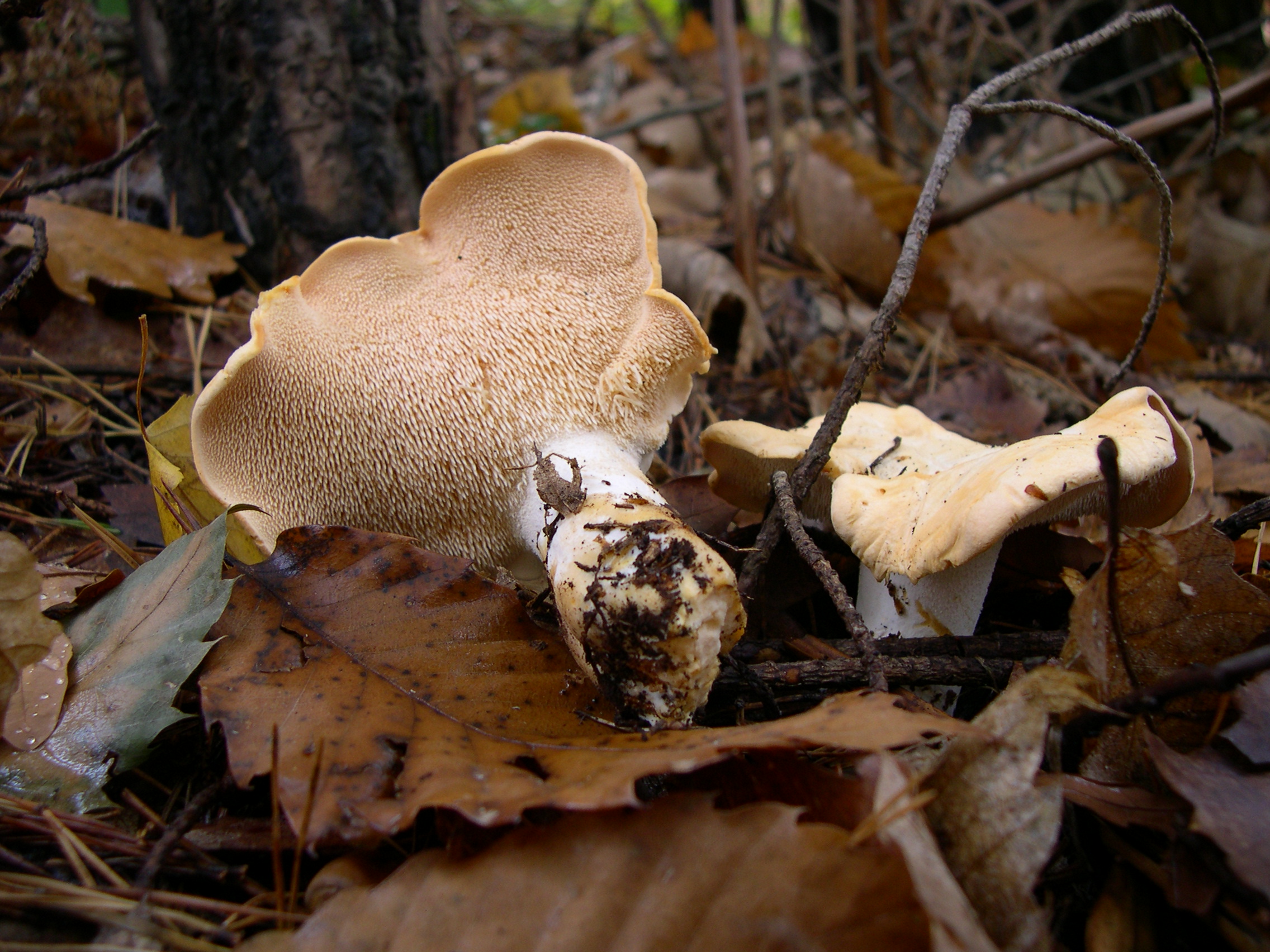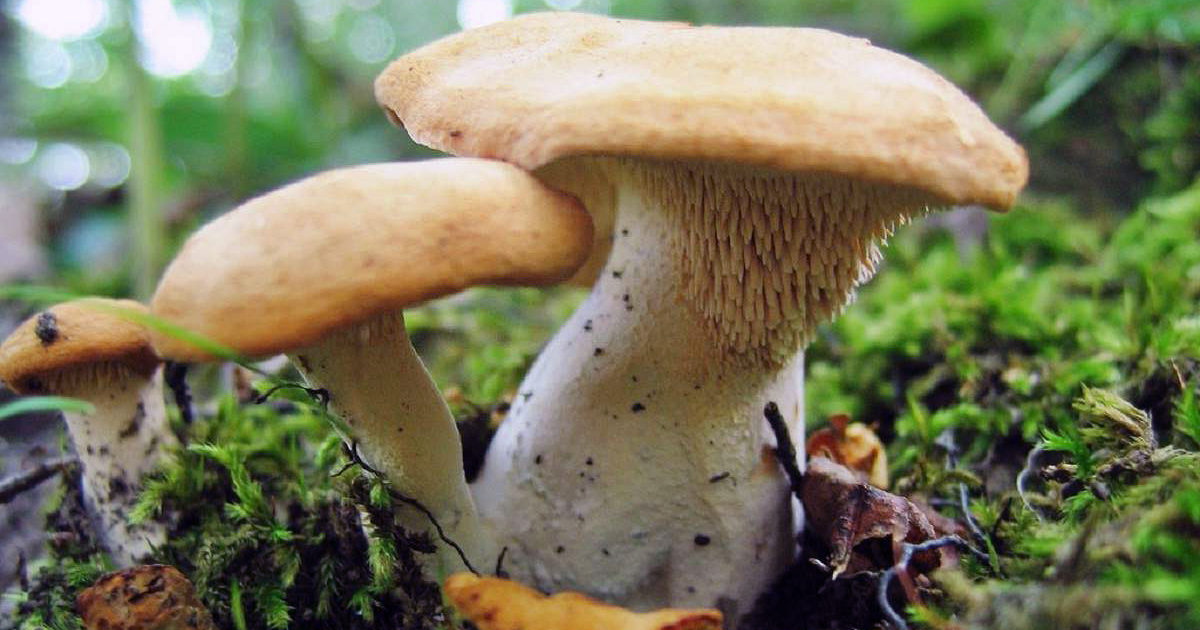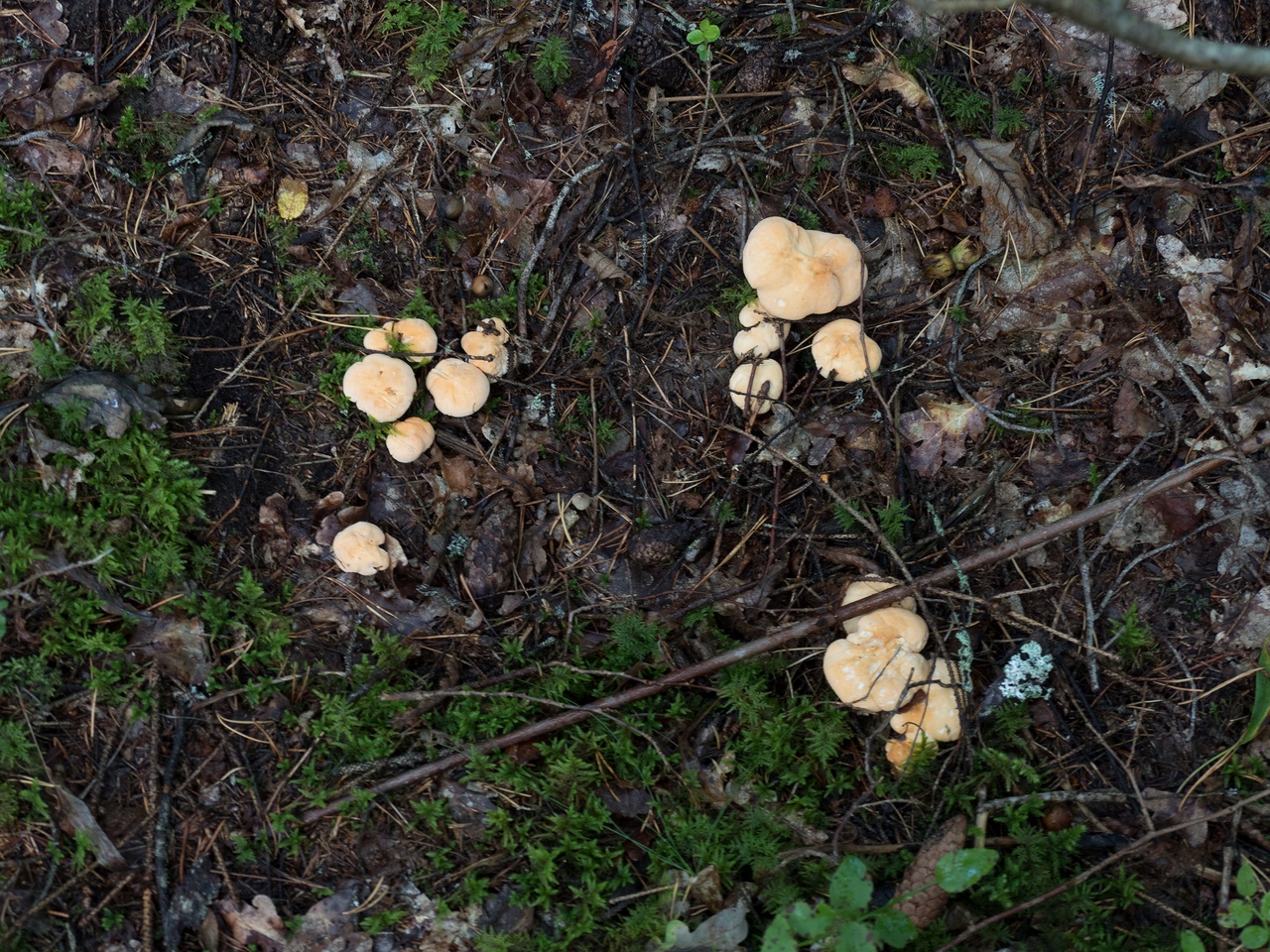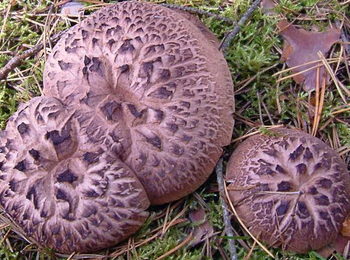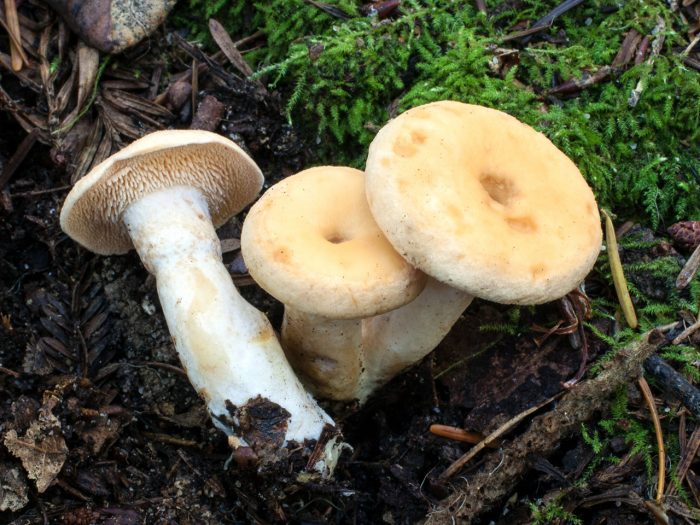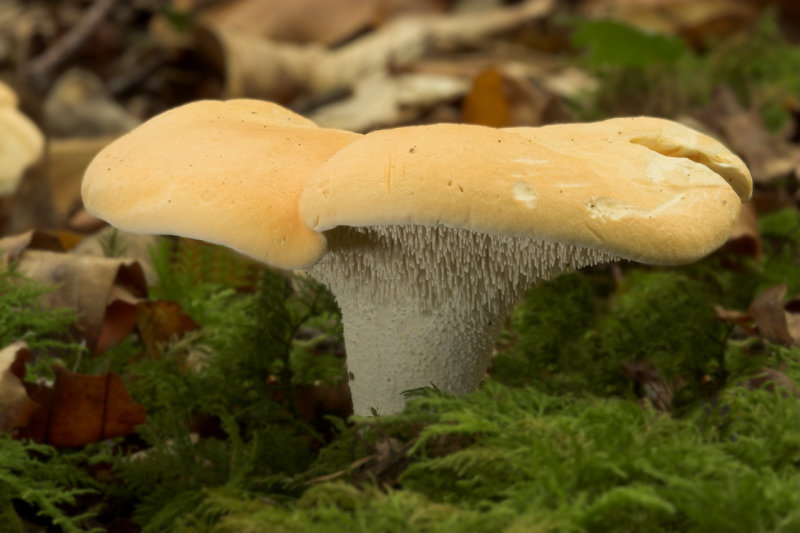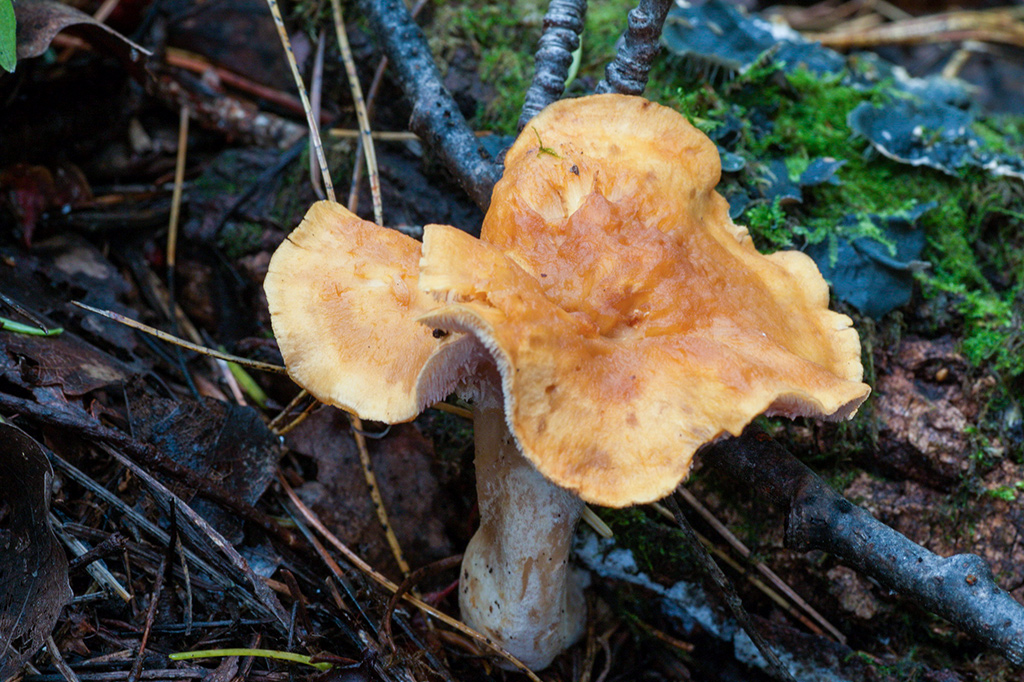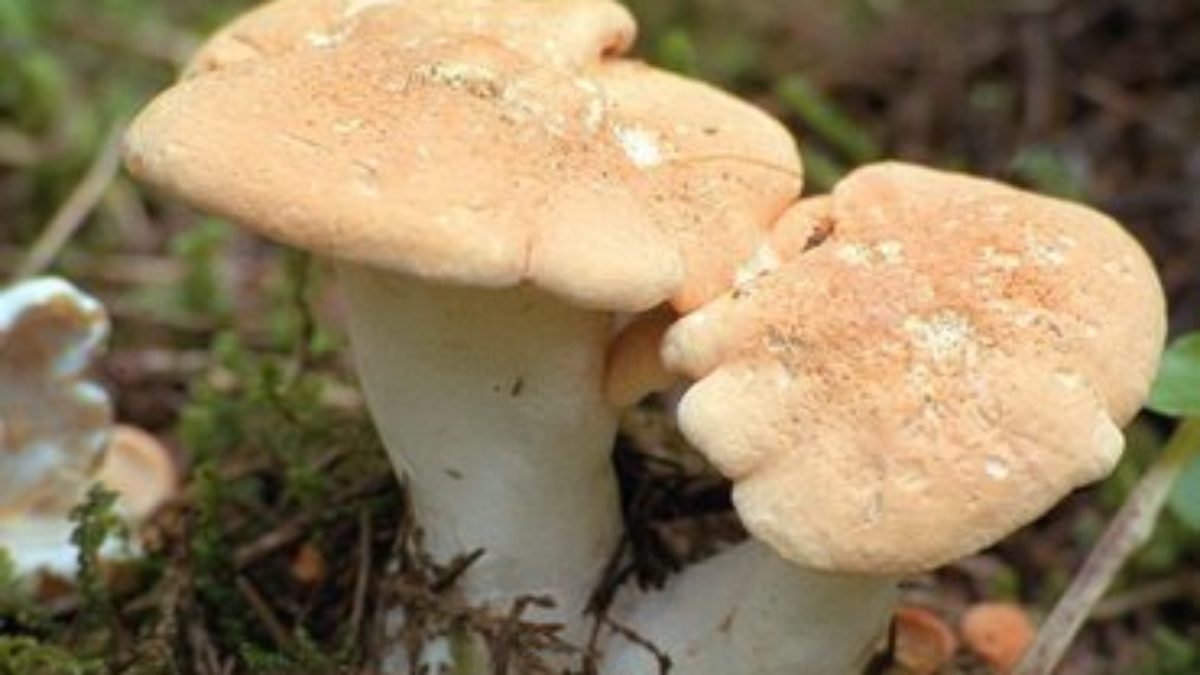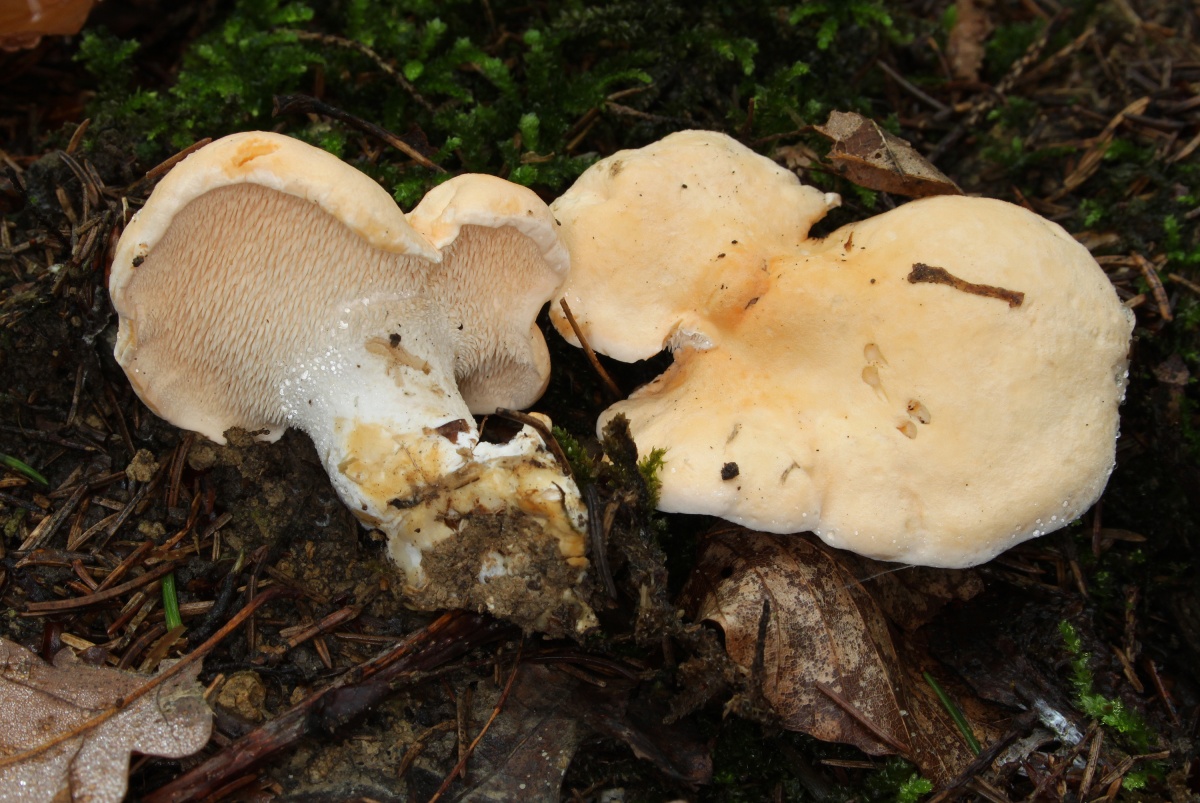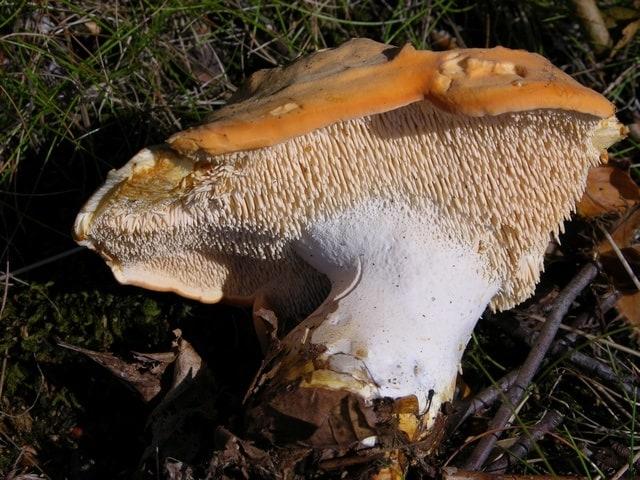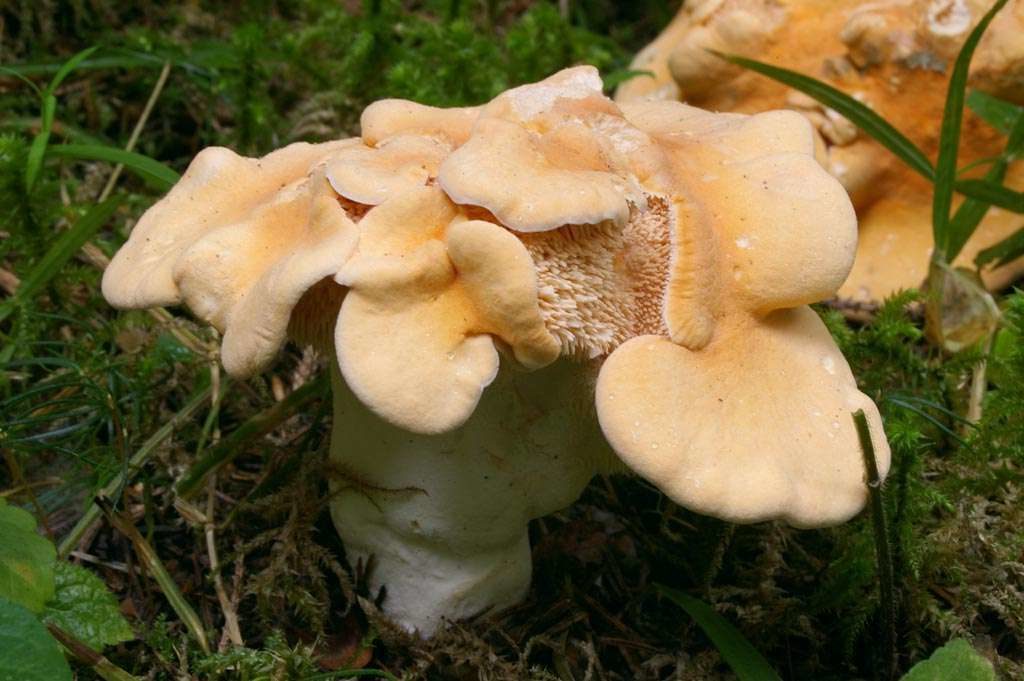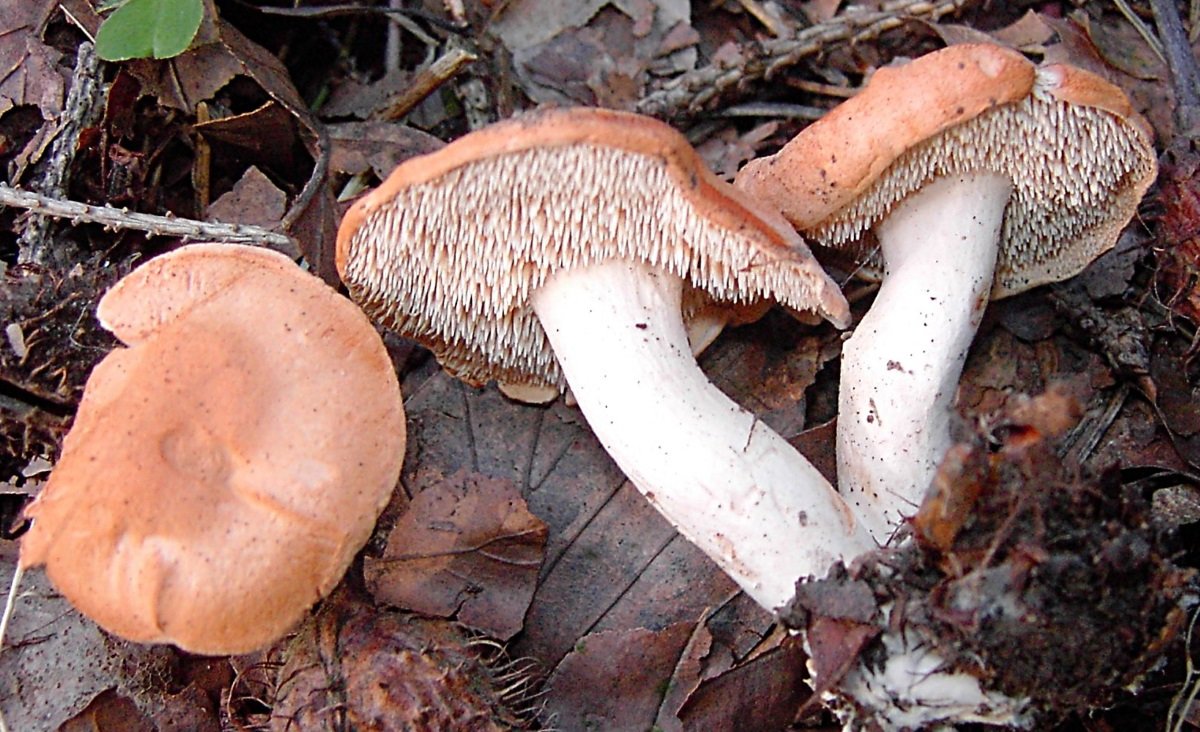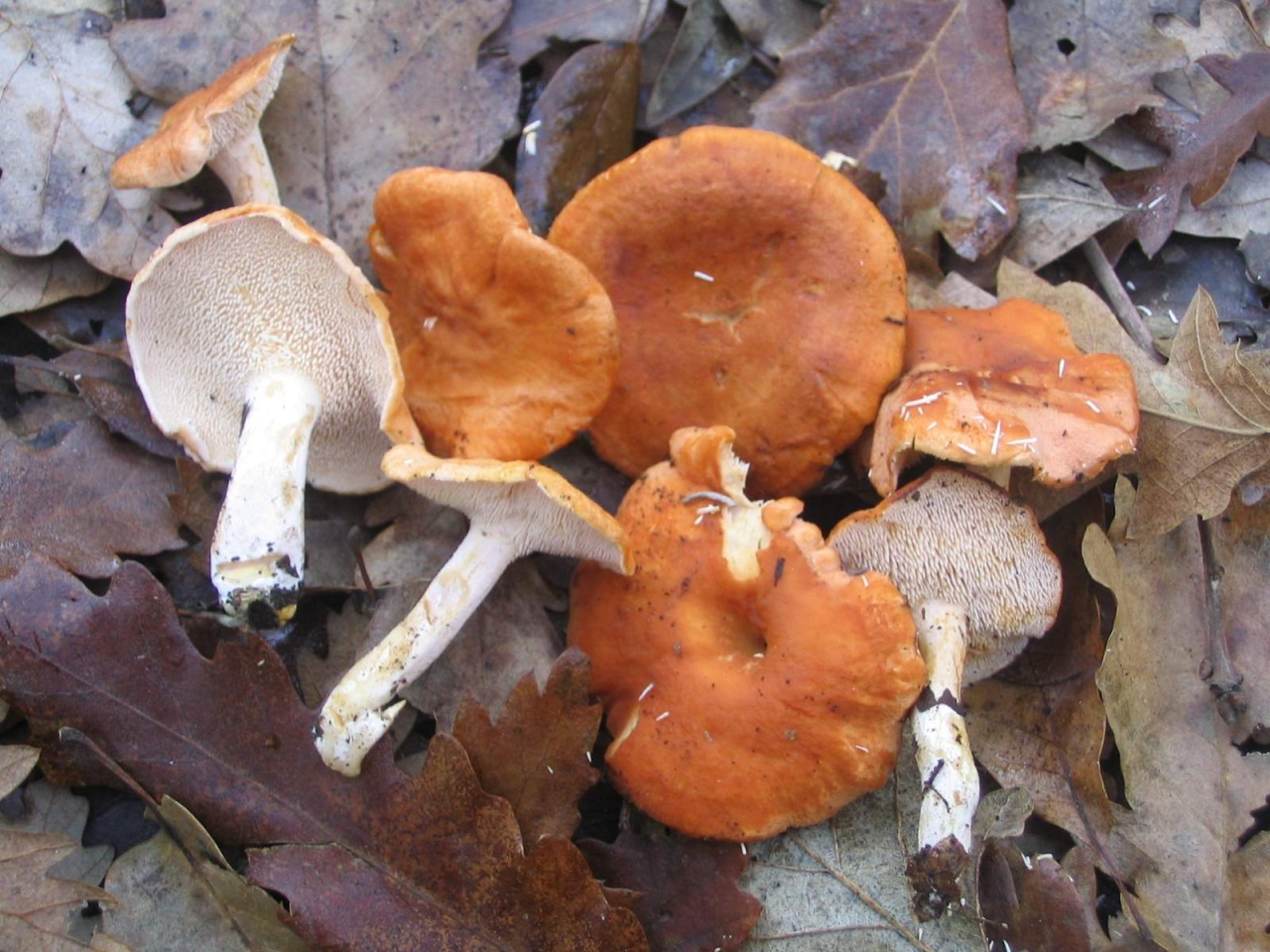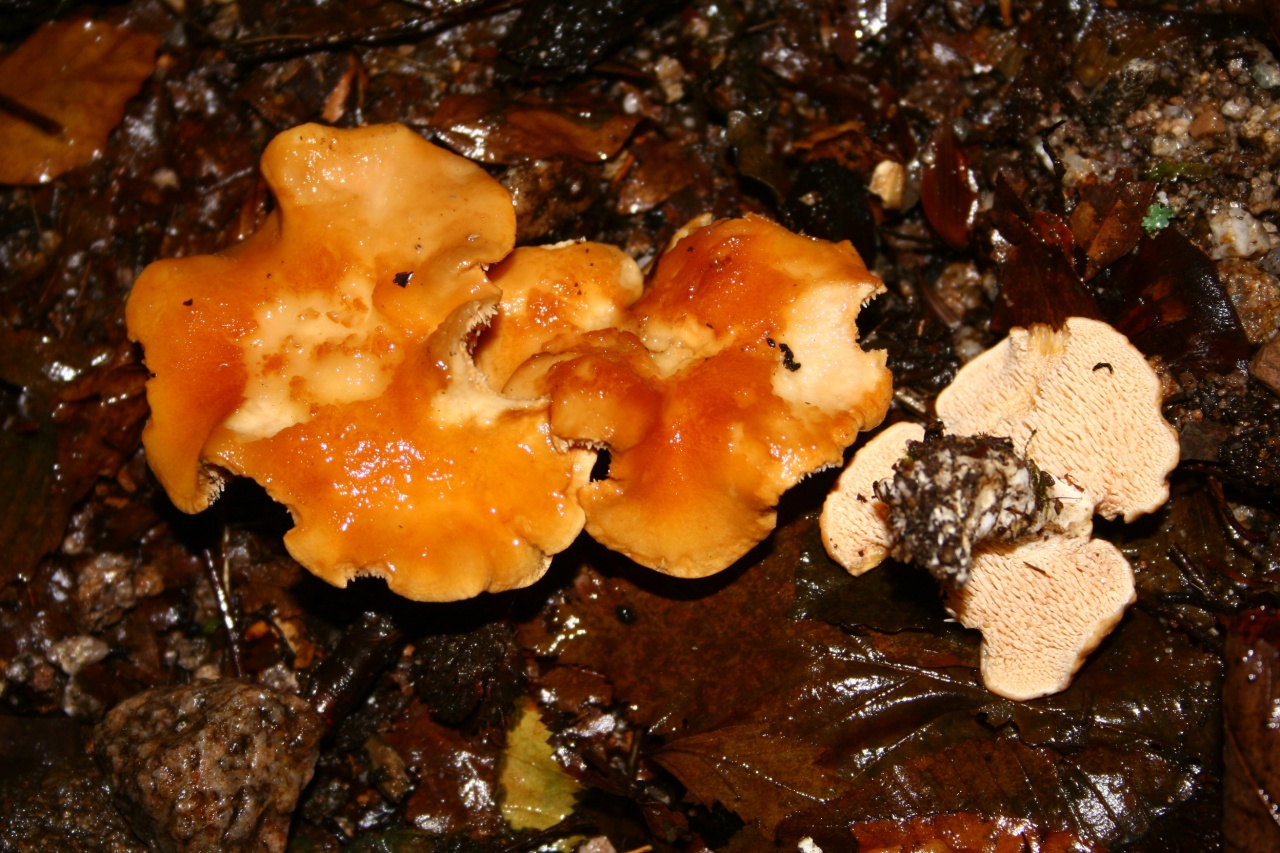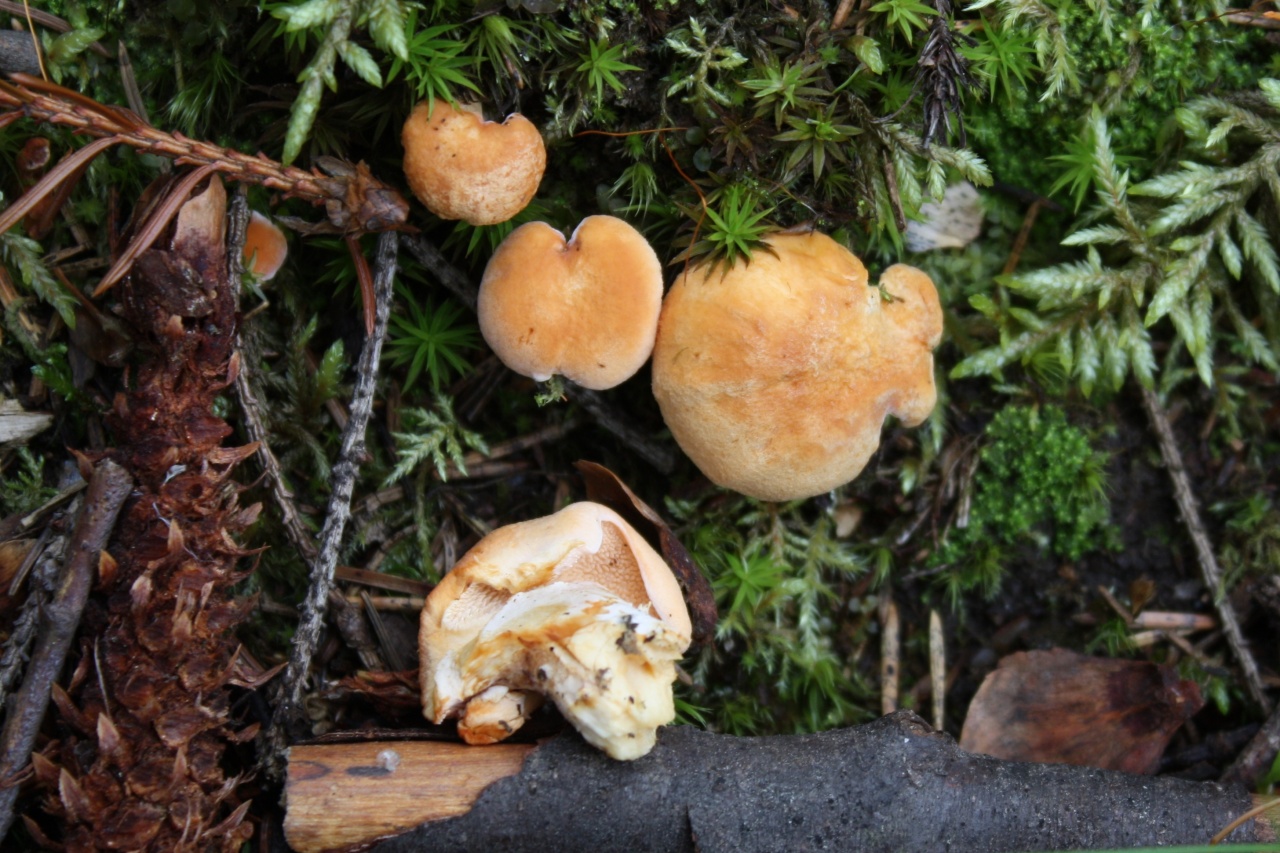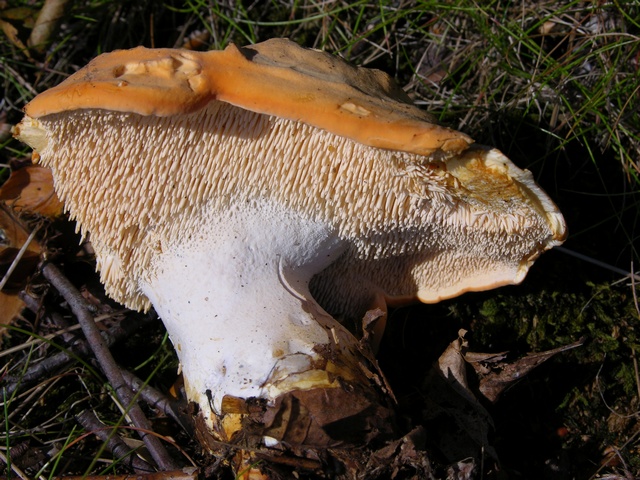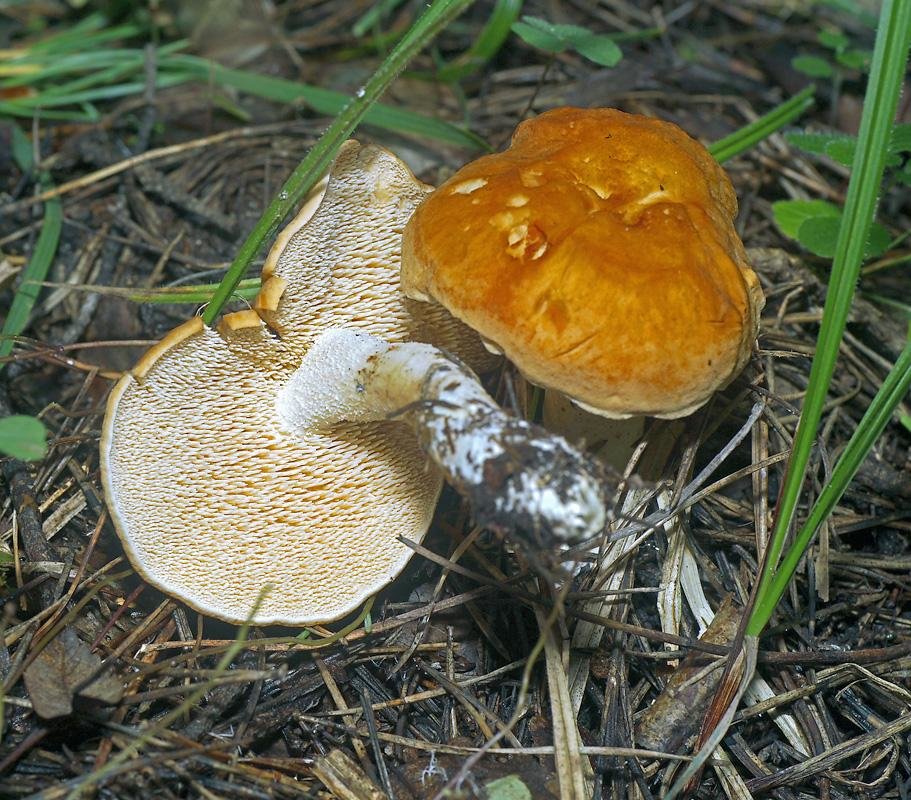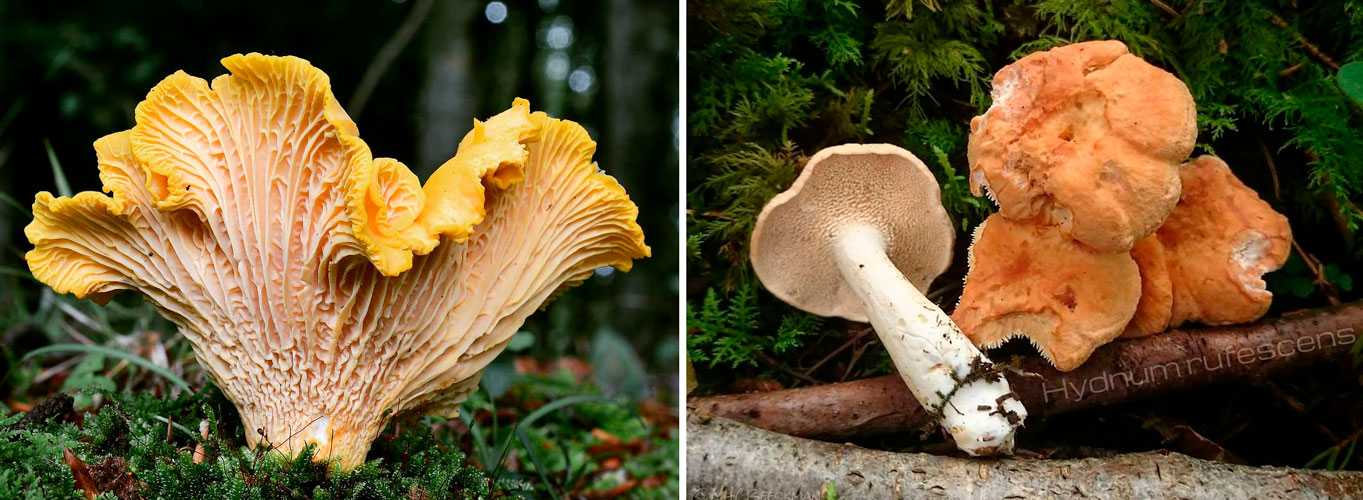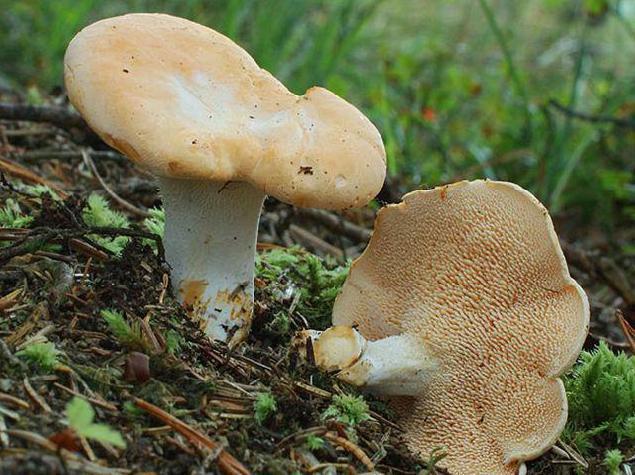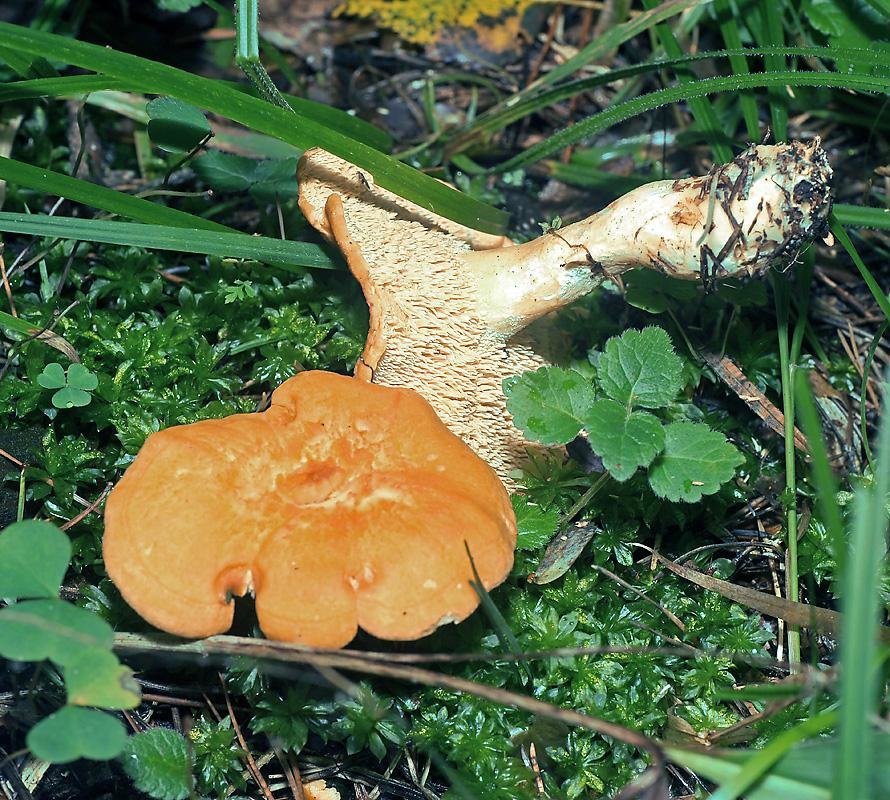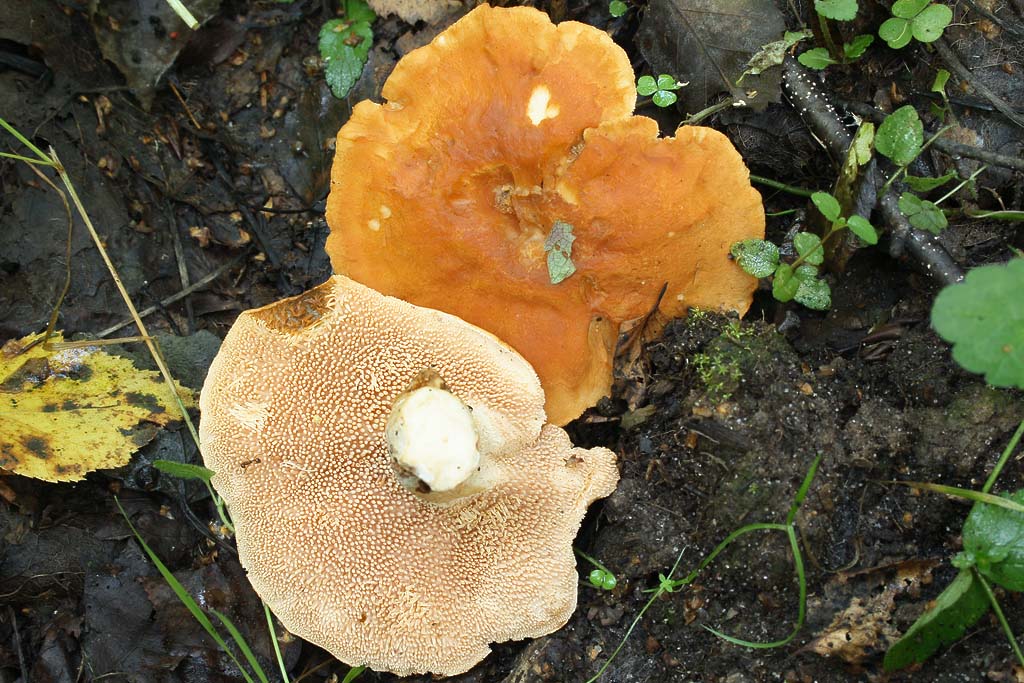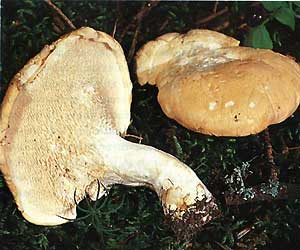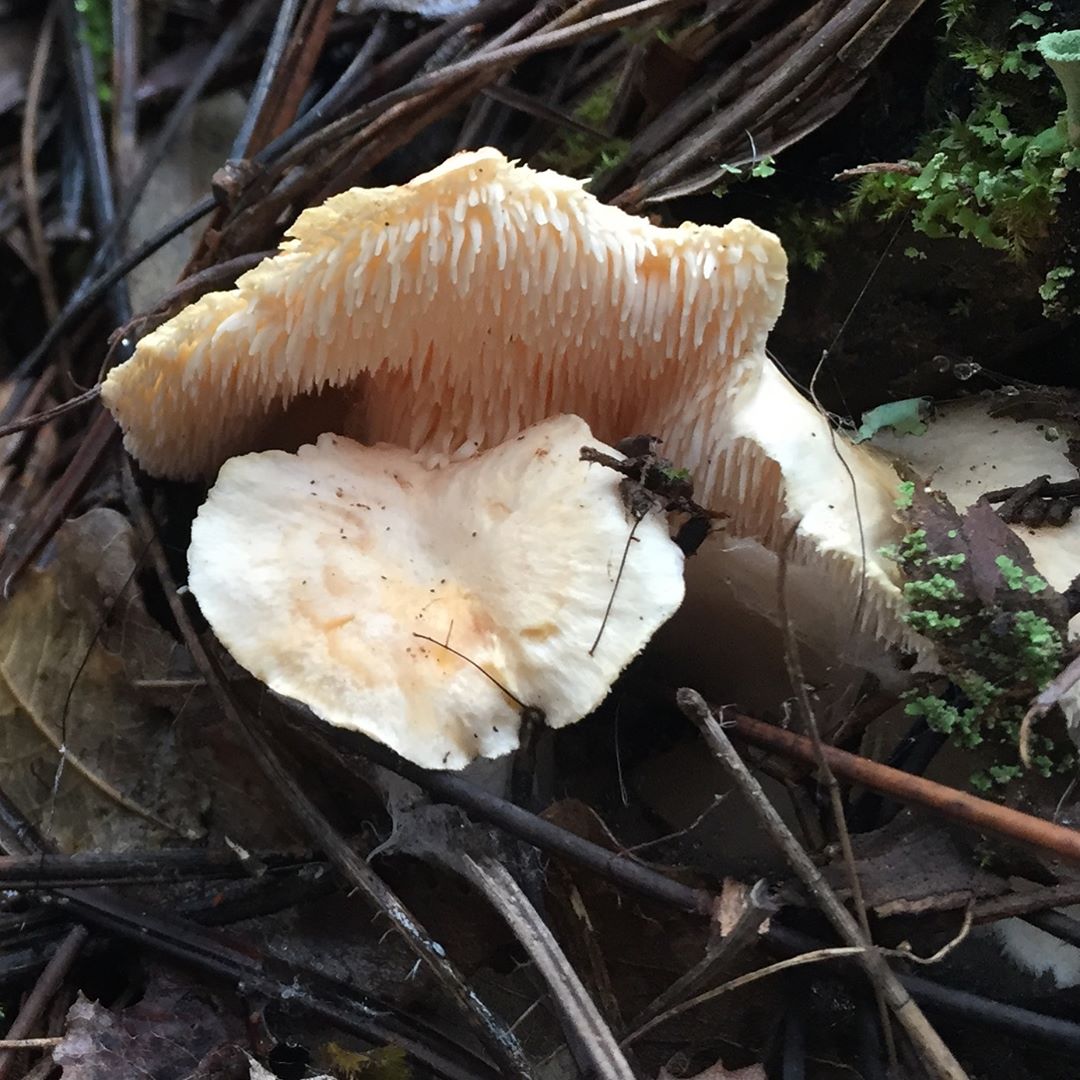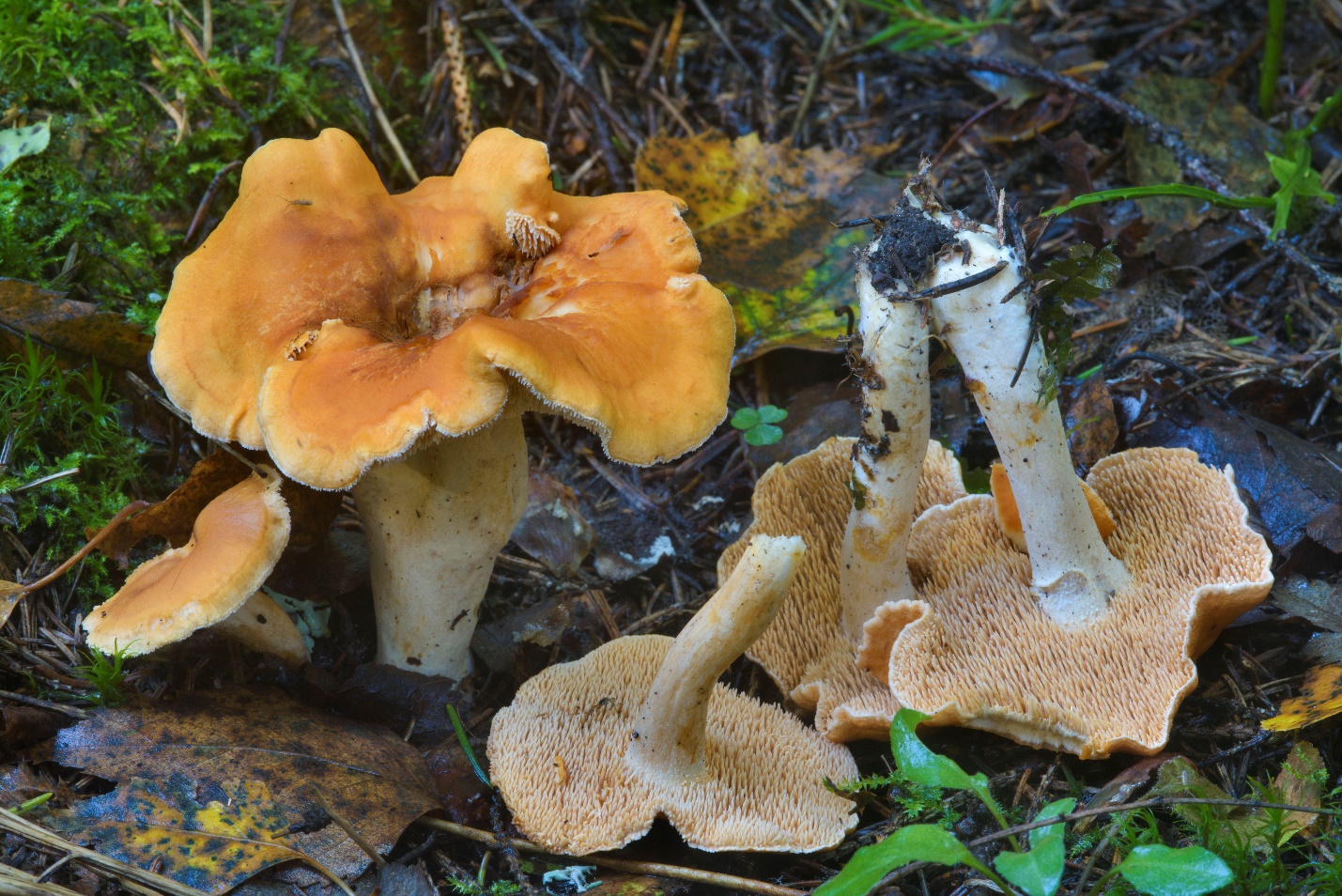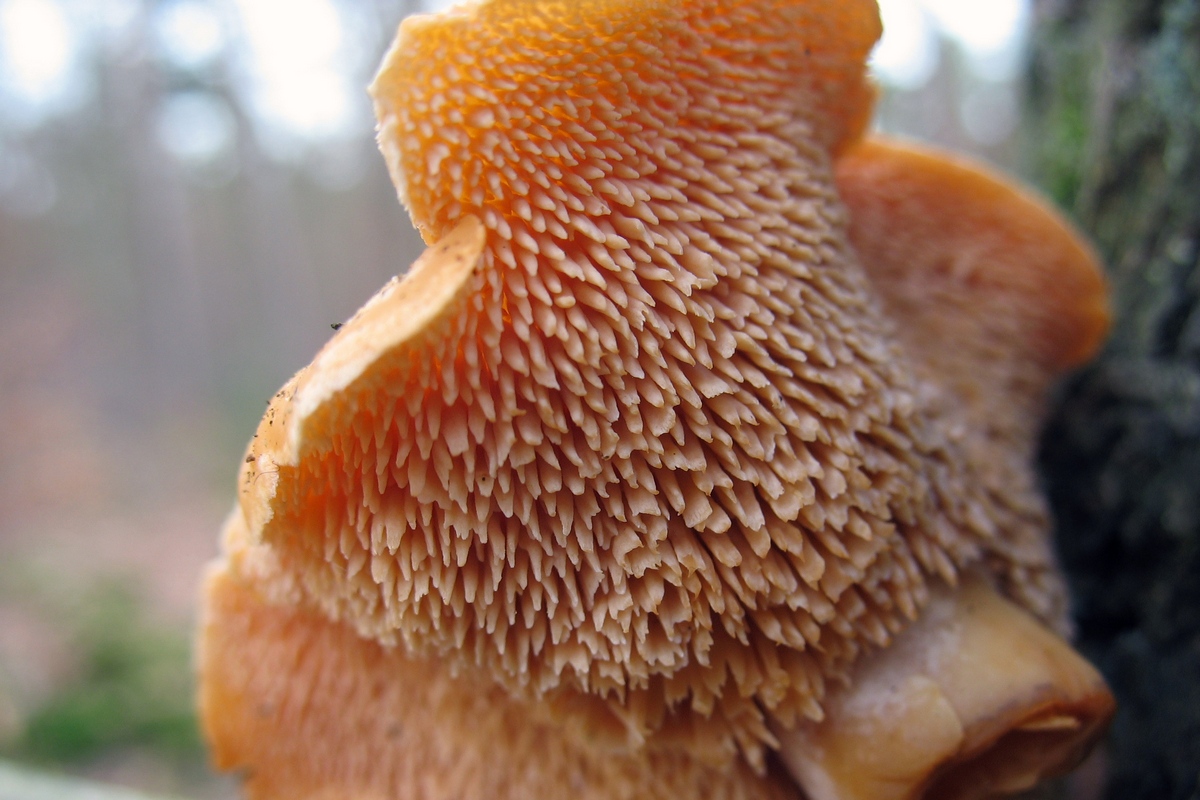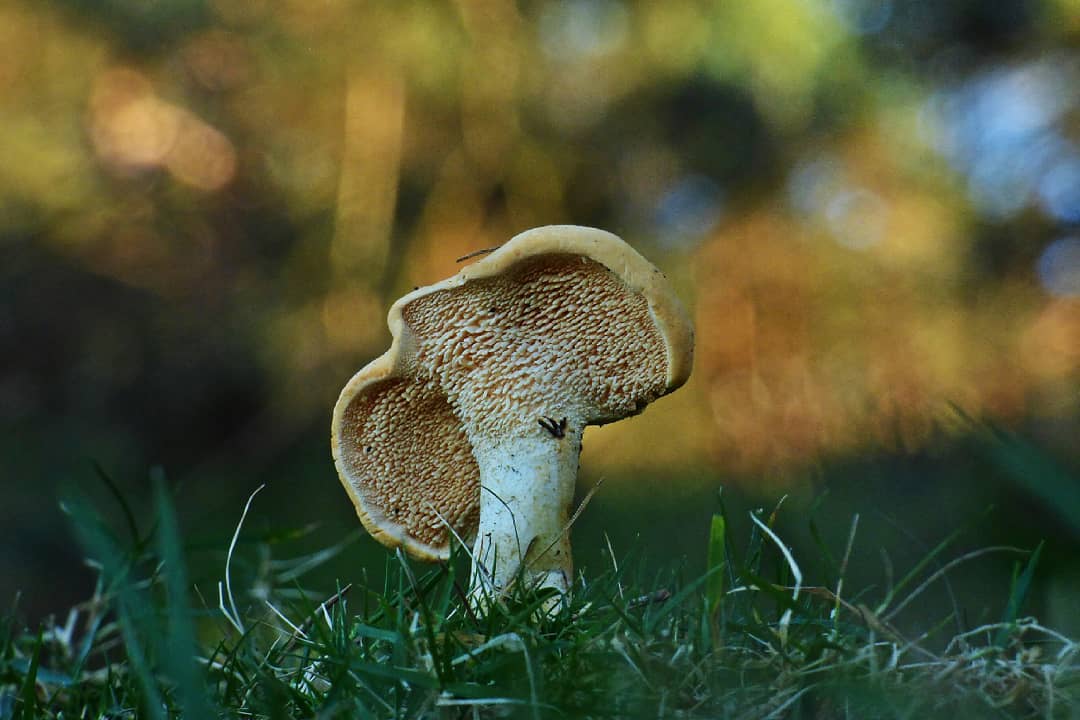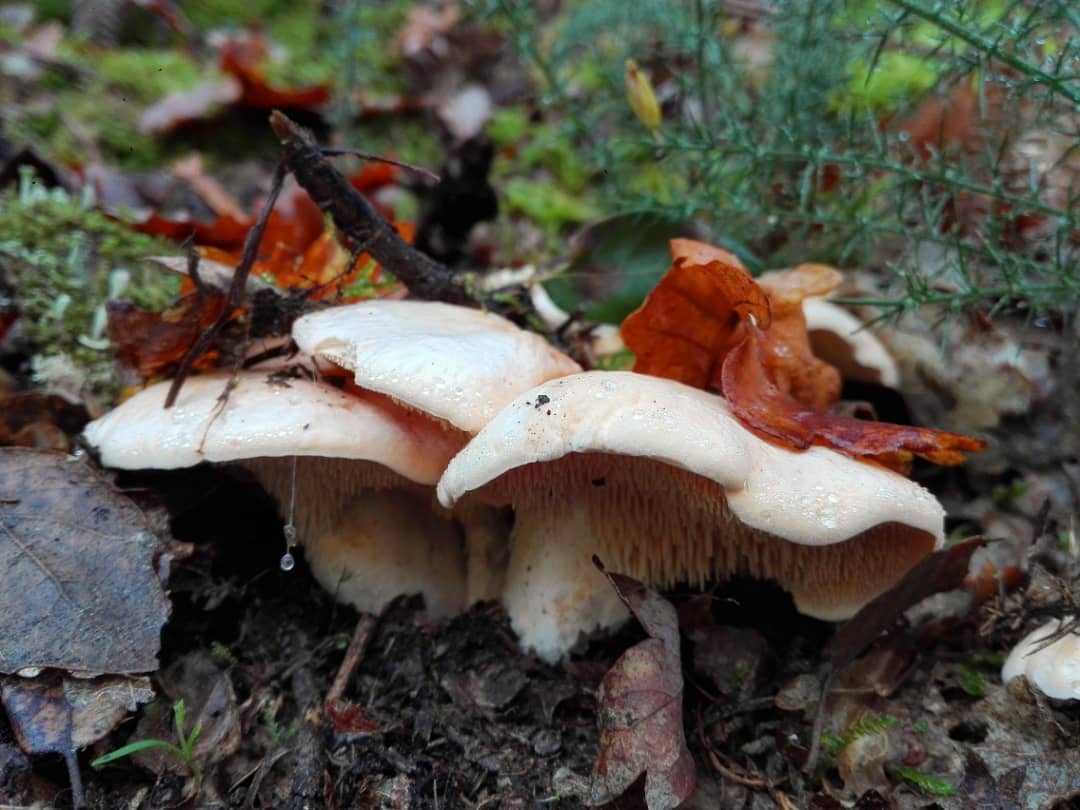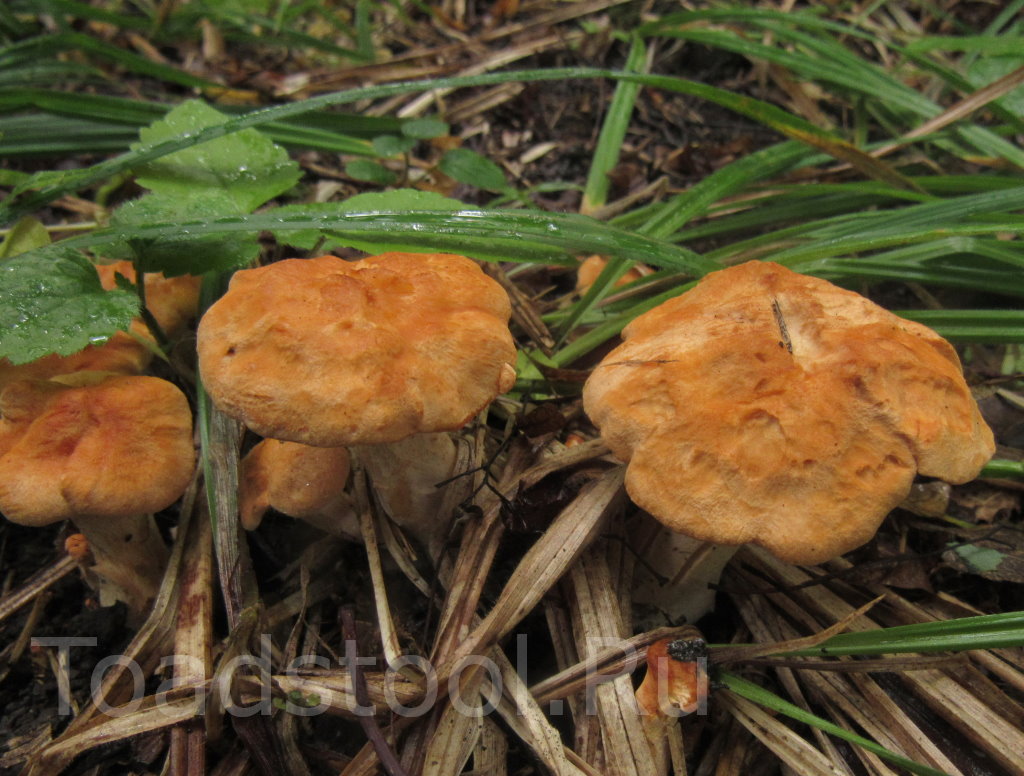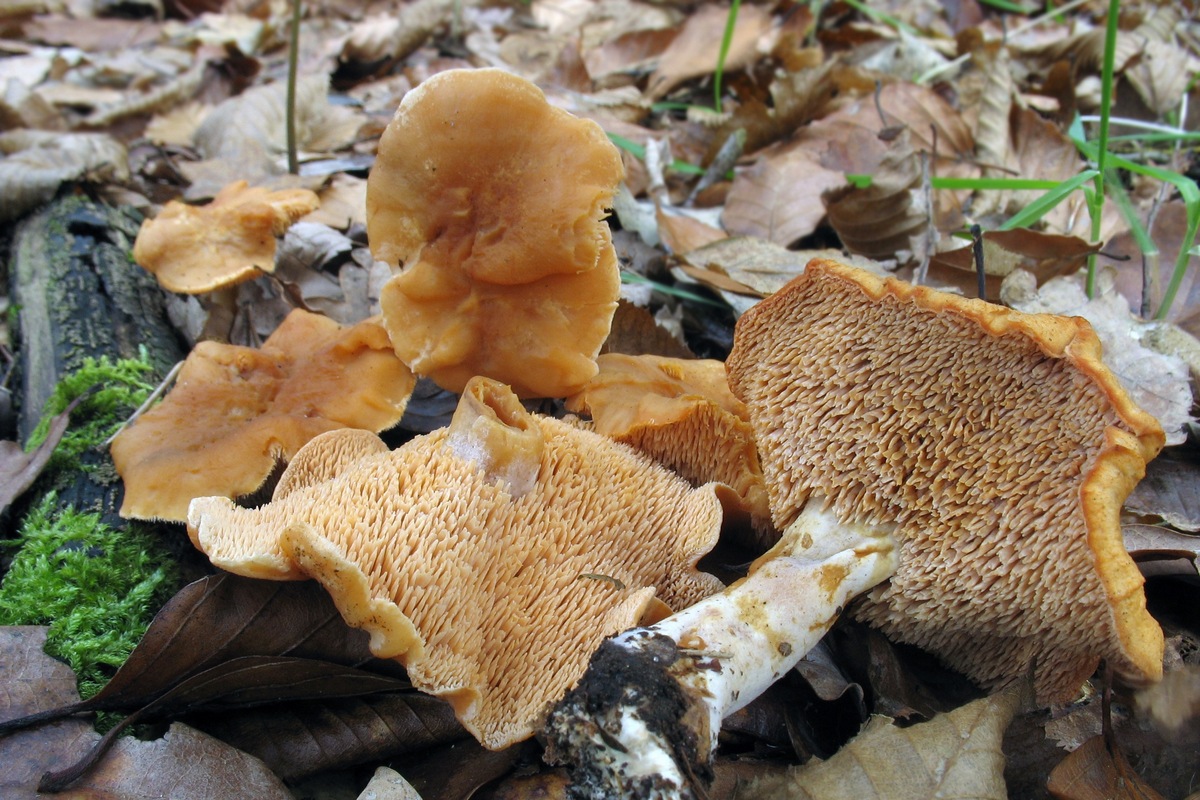Yellow Hericium (Hydnum repandum)
Other names:
- Hydnum notched
- Dentinum notched
Yellow Hericium (lat.Hydnum repandum) is a mushroom of the genus Hydnum of the Hericium family.
Yellow Sheep's Man's Hat:
Yellowish in color (from almost white to orange - depending on growing conditions), smooth, 6-12 cm in diameter, flat, with curved edges, often irregular in shape, often grows together with the caps of other mushrooms. The cuticle does not come off. The pulp is whitish, thick, dense, with a pleasant smell.
Spore-bearing layer:
On the back of the cap there are pointed spines that easily break off and crumble. The color is somewhat paler than the cap.
Spore powder:
White.
Leg:
Length up to 6 cm, diameter up to 2.5 cm, cylindrical, compact (sometimes with cavities), often widened at the base, somewhat paler than the cap.
Spreading:
It grows from July to October (mainly in August) in large groups in deciduous, coniferous and mixed forests, preferring a moss cover.
Similar species:
The yellow Hericium is very similar to the reddish-yellow Hericium (Hydnum rufescens), which is smaller and has a reddish tinge of the cap. But most often, Hydnum repandum is confused with the Common Chanterelle (Cantharellus cibarus). And it's not that scary. Another thing is bad: apparently, considering the Yellow Ezhok to be an inedible mushroom, they break it, knock it down and trample it for its resemblance to the folk chanterelle. Morons, eh?
Edibility:
Hericium yellow Normal edible mushroom. In my opinion, it is completely indistinguishable in taste from a chanterelle. All sources indicate that in old age, Ezhok yellow is bitter, and therefore inedible. Do what you want, but I didn't notice anything like that, although I tried. Probably, the bitterness of a blackberry is something from the category of inedibleness of a spruce mushroom. "It happens."
Remarks All this, of course, is very subjective, but for me Hydnum repandum was and remains a kind of "almost chanterelle". It seems that consumer qualities are exactly the same, but - a little bit different. A little, just a little, but not that. And it crumbles, unlike more willingly, and some kind of dryish - the chanterelle itself is rubber rubber, and then there is also dryness - and the worms eat it, even if not very willingly, but it happens ... And they also write, he sometimes tastes bitter ... But , be that as it may, this mushroom still belongs to the good and reliable. And it can be terribly insulting to find whole plantations of a hedgehog, beaten, trampled, broken ... And you can always see: they broke it on purpose. Not just turned up under the foot. Eh, I think at such a moment, to meet lovers ...
However, it happened, and met. Once I met on a forest path a couple of mushroom pickers, grandfather and grandmother, both summer residents. And I am with a basket, half yellow from the hedgehogs. We talked about roads and directions. My grandfather came up to me, looked into the korizin, said: “You've got some toadstools!” And set out to help me get rid of suspicious mushrooms. And then I realized whose arts the whole forest is full of ...
Description of the yellow hedgehog
Hericium grows abundantly in the middle zone and northern regions of the Eurasian and North American continents, similar in their climatic conditions. But despite this circumstance, the vast majority of mushroom pickers bypass these fruits, referring to their strange appearance, although in fact this is more of an advantage, and not a lack of edible, rather tasty and very useful hedgehogs, which simply cannot be confused with some a different kind.
Features of the species Hydnum repandum
What is so unusual about the yellow hedgehog that makes it unique among the completely unthinkable number of representatives of the kingdom of the Mushrooms in our forests? Only one glance at the cap of the mushroom will help to answer this question - it is strong, bright, and most importantly, dotted with numerous small thorns in the area of the hymenophore. It is these spines, often descending along the stem to the very base of the fruit stem, that make the variety unlike any other.
The size of these small, thin needles, densely dotting the lower part of the mushroom cap, varies from 4 to 7 mm, depending on age.Over time, the color changes, as well as the structure of these specific growths: light, elastic at a young age and easily crumbling, dark - at maturity. At the end of the life cycle of the fungus, the thorns turn brown, becoming the same color as the cap, and begin to crumble on their own.
As for the shade of the mushroom surface, it also changes throughout its life cycle. So, at the initial stage of development, this part has a delicate yellow or cream tone, gradually turning into a more saturated nut color. Closer to old age, the hat turns brown, and then it completely becomes dark and shriveled. Its shape is also prone to change, which at first has a domed appearance, and later spreads its fields, deepening in its inner part.
The edges of the mushroom cap are almost always tucked inward, with numerous cracks that form after the change in shape. Hericiums are often attacked by forest insects, which are saved in dry weather by the moisture contained in the pulp. That is why the inseparable velvety skin of these wonderful mushrooms often looks slightly bruised. The property to grow in colonies, forming lobes protruding beyond the cap, often leads to accretion of some specimens.
Under the head of the fruit is a hymenophore with its unusual spines, and in it there is a fine white spore powder for reproduction. Directly adjacent to it is a cylindrical leg - white with a slight yellowish tinge, thick and strong. Most often, the diameter of this part of the mushroom is about 3 cm, while the height does not exceed 7 cm.
The stem often thickens downwards, growing together at the base with other fruits. With aging, the base of the fungus acquires a dirty tint and a more fragile structure due to the formation of characteristic voids in it. The mushroom pulp is also quite fragile, despite its external density and uniformity. It is noteworthy that when pressed, its cut tends to acquire a rich orange hue, which is another unique property of the variety.
Edible mushroom or not
Until now, the debate over the edibility of the barnacle, classified in the group of conditionally edible mushrooms, does not subside, and this time the problem is not at all in its non-standard appearance. The variety has very contradictory organoleptic qualities, on the one hand, it demonstrates the most delicate and very pleasant fruity aroma, characteristic only of milk mushrooms, and on the other, it has a slight bitterness, which turns from piquant into a pronounced one as the fruit body matures.
Meanwhile, it is quite easy to get rid of it if you carry out proper preparation of the mushroom, although all these techniques are relevant only for young specimens that have a slight pleasant sourness. True gourmets compare the barnacles with chanterelles, highlighting several significant advantages of this unpopular variety.
So, unlike the delicious forest gifts, they have a rather high nutritional value. And in the process of heat treatment, hedgehogs do not lose volume, retaining their pleasant elastic structure.
Interesting! The species does not have poisonous counterparts and does not contain toxic substances, being inherently an absolutely edible and safe mushroom.
The benefits and nutritional value of the mushroom
The mushroom, due to its composition, boasts a high content of fiber, carbohydrates and proteins. It also contains all the necessary macronutrients and micronutrients. The energy value of 100 grams of mushroom is 22 Kcal.
Vitamins contained in blackberries:
- Vitmin PP;
- vitamin C;
- fish flavin;
- vitamin B4;
- pantothenic acid;
- betaine;
- vitamin D;
- vitamin D2;
- vitamin K
As for microelements and macronutrients, they are as follows in the black man's man:
- magnesium;
- phosphorus;
- calcium;
- potassium;
- sodium;
- selenium.
The product also contains:
- aminopropanoic acid;
- diaminohexanoic acid;
- leucine;
- glutamic acid;
- amino succinic acid.
Due to its unique composition, the mushroom is actively used in folk medicine.Active ingredients that help to cure many diseases:
- Campesterol. In its structure, this substance resembles cholesterol. When a substance enters the body, it mixes with bad cholesterol, this contributes to the natural exit from the human body.
- Glutamic acid. Thanks to her, the taste of the mushroom becomes spicy, regenerates muscle tissue and is a source of energy.
- Aspartic acid. It normalizes the endocrine system, it is also a growth hormone.
- Potassium maintains the body's water balance, also improves heart rate and normalizes blood pressure.
- A nicotinic acid. Takes an active part in the synthesis of proteins and energy metabolism.
Description of yellow barnacle
The diameter of the cap reaches 3-12 centimeters. The cap is dense, fleshy, its surface is bumpy, and its shape is irregular. In young yellow urchins, the cap is slightly convex with a slightly velvety surface, the edges are bent down.

When the mushrooms age, the shape of the cap becomes flat with a concave center, and the edges become lobed or wavy. Often, the caps of neighboring mushrooms grow together.
The skin of the cap does not come off. The color of the cap can be pinkish-yellow, light hazel, light ocher and reddish-orange; when ripe, it becomes darker and acquires an orange tint. In dry weather, the cap fades to a whitish or pale yellow color.
The hymenophore is formed by four spines in the form of needles descending to the pedicle, which sometimes can reach the very base of the pedicle. In young specimens, the spines are elastic and short, and their color is whitish or yellow-pink. In mature mushrooms, the length of the spines reaches 4-8 millimeters, they become the same color as the cap, easily break off and crumble.

The length of the leg can reach 3-5 centimeters, and in large specimens it can reach up to 8 centimeters. The diameter of the leg ranges from 1.5 to 4 centimeters. The leg is solid, dense, cylindrical or curved. At the base, it is most often extended. In relation to the cap, the leg is located in the center. The surface of the leg is smooth, near the base it becomes felt. The color of the leg is yellowish or whitish, but as the fungus grows, it becomes darker.
Spore white powder. Spores are ovoid or elliptical in shape. They are colorless and smooth.
Growing places
Hericiums yellow grow in coniferous and deciduous forests. They form mycorrhiza with a variety of coniferous and deciduous trees. They can grow on any soil, but limestone is preferred, especially in areas with a moss cover.

The most abundant yellow barnacles are found in light birch forests. They are widespread mushrooms found in North America and Eurasia. Also, these mushrooms grow in the European part of our country, in the Far East and Siberia. They grow in temperate climates and cold regions.
The fruiting season is summer-autumn. Fruiting bodies grow singly, in a heap, or in small groups, while the mushrooms merge almost into a single whole - not only the caps, but also the legs grow together. Yellow Hericiums sometimes grow in "witch circles" or in rows.
Edibility of yellow hedgehog
Hericium yellow is an edible mushroom. Many mushroom pickers claim that these mushrooms do not differ at all from chanterelles in taste. But old hedgehogs start to taste bitter, so they are not suitable for eating.

It is noteworthy that during heat treatment these mushrooms remain practically the same size, in addition, their structure remains unchanged. The flesh of a barnacle gives off a slight sourness and has a delicate aroma, but this applies to young specimens.
Yellow Hericiums are suitable for preparing a variety of dishes: they can be salted, boiled, fried and dried. Fried mushrooms with sour cream and onions are very tasty.
In France and other European countries, yellow hedgehogs are used as a side dish; they are served with meat and fish dishes with a variety of sauces.They are often added to soups and various salads.

How to cook a yellow hedgehog
You can cook mushrooms in any way - boil, fry, pickle. Both young and mature specimens are suitable for culinary processing. During preliminary preparation, the mushroom harvest should not be soaked in water, yellow hedgehogs will become brittle.
Mushroom preparation
The collected mushrooms are cleaned of debris, washed and dried
The fruits brought from the forest are immediately processed. Long-term storage reduces the nutritional value of the forest delicacy.
Detailed description of the process:
- Mushrooms are cleaned of debris and sorted out.
- Large ones are cut into pieces so that it is convenient to cook. The caps have no skin, so there is no need to peel them.
- Having washed well in a basin or under running water, cut off the base of the leg with a sharp knife, remove damaged and contaminated places by insects.
- Then they are dried on a clean towel, and the intended dish is prepared, canned or dried for the winter.
Advice! Housewives recommend peeling off the spines of the hymenophore when cooking soups with a hedgehog.
How to fry
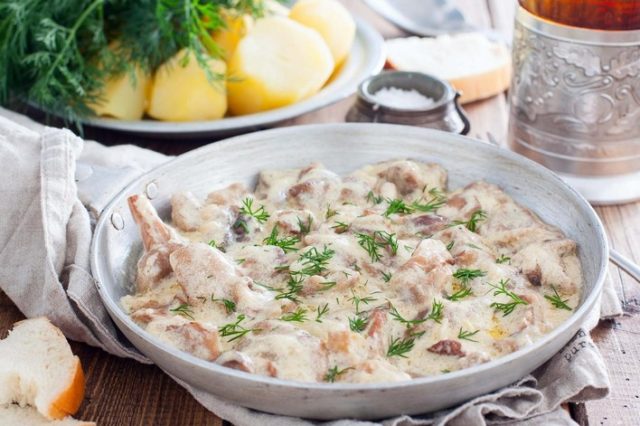
Yellow herd's flies, fried in cream
Preparing a delicious mushroom snack is very simple. To do this, you need the following products:
- mushrooms - 1 kg;
- onion - 1 pc.;
- carrots - 1 pc.;
- cream - 1 tbsp.;
- lean oil and spices - as needed.
A detailed description of the frying process:
- After preliminary preparation, the mushrooms are sent to the pan with heated butter or vegetable oil.
- In a separate frying pan, brown chopped onions and a little carrots (optional) until golden brown.
- Add onions and carrots to the mushrooms, salt to taste, pour in heavy cream, keep on medium heat for 3-5 minutes.
How to pickle
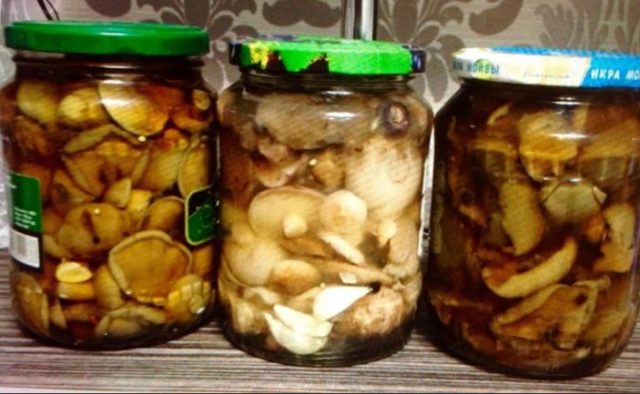
Pickled yellow hedgehogs are eaten 12 hours after cooking
Mushrooms will not lose their shape and volume during pickling, will be crispy and very tasty.
Products for 720 ml jar:
- black hairs - 450 g;
- onion - 1 pc .;
- garlic - 1 clove;
- salt - 1 tbsp. l .;
- vinegar 5% - 2 tbsp. l .;
- rapeseed oil - 1 tbsp. l .;
- black peppercorns - 10 pcs.;
- bay leaf - 1 pc.;
- boiling water for the marinade - 250 ml.
Process description:
- Young specimens are selected for pickling. Prepared mushrooms are poured with boiling water and left to infuse for 10-15 minutes.
- Throw in a colander and rinse with running water.
- On the bottom of a clean glass jar, place a peeled, halved onion and a chive.
- Pour in salt, pour in rapeseed oil and vinegar, add peppercorns and 100 ml of boiling water.
- Prepared black man's men are placed in the jar.
- Add 150 ml of boiling water to the top, tighten with a tin lid.
- Shaking the jar so that its contents mix well, turn it upside down. Leave in this position for one hour.
- After this time, the jar is placed on the bottom and put into the refrigerator.
Important! You can store such a blank for a month
How to freeze
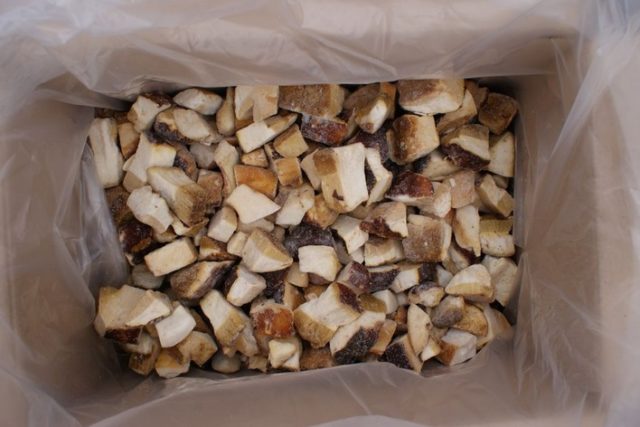
Before freezing, the mushrooms are cut and put in bags.
Hericiums can be frozen fresh or pre-boiled in boiling water for three minutes. In the first case, clean, well-washed and dried mushrooms are packed in bags and frozen. Boiled black hairs are thrown in a colander, allowed to drain, then they are also packed in bags and frozen.
Salting

Hot Salted Hericiums, Ready to Eat in Two Weeks
For salting, the following are used as spices:
- garlic;
- dill umbrellas;
- horseradish leaf;
- peppercorns.
Some mushroom pickers, in order not to interrupt the aroma, use only garlic for pickling. The recipe below is good because the mushrooms do not need to be soaked beforehand, as with cold salting.
Products:
- yellow barnacles - 1 kg;
- salt and spices - as needed;
- water - 1 l;
- vegetable oil - 50 ml.
Process description:
- Prepared mushrooms are placed in boiling water, adding 0.5 tsp per liter of water. salt. When the water boils, cook for 3-5 minutes.
- The foam can be left on, the boiled hedgehogs are thrown in a colander and washed under running water. Allow to drain for 15-20 minutes.
- Horseradish leaves, allspice and black peppercorns, garlic are placed on the bottom in a clean glass jar, two pinches of salt are poured.
- Put the mushrooms in a jar in layers of 3-4 cm, sprinkle with salt (about 1-2 pinches). Dill umbrellas and garlic are placed in the middle of the jar.
- The mushroom layers are well tamped by hand. When the last layer is laid, 3-4 cm should remain to the edge of the can.
- A horseradish leaf is placed on top as a shutter, a pinch of salt is poured and a little vegetable oil is poured.
- Cover the jar with a clean nylon lid and refrigerate.
Important! Do not fill the jar with mushrooms to the very top, during the salting process they will rise slightly and can rip off the lid
Hericium flake (Sarcodon Imbricatus)
- Other names for the mushroom:
- Hericium is variegated
- Variegated sarcodon
Synonyms:
- Hericium tiled
- Hericium scaly
- Sarcodon tiled
- Variegated sarcodon
- Kolchak
- Sarcodon squamosus
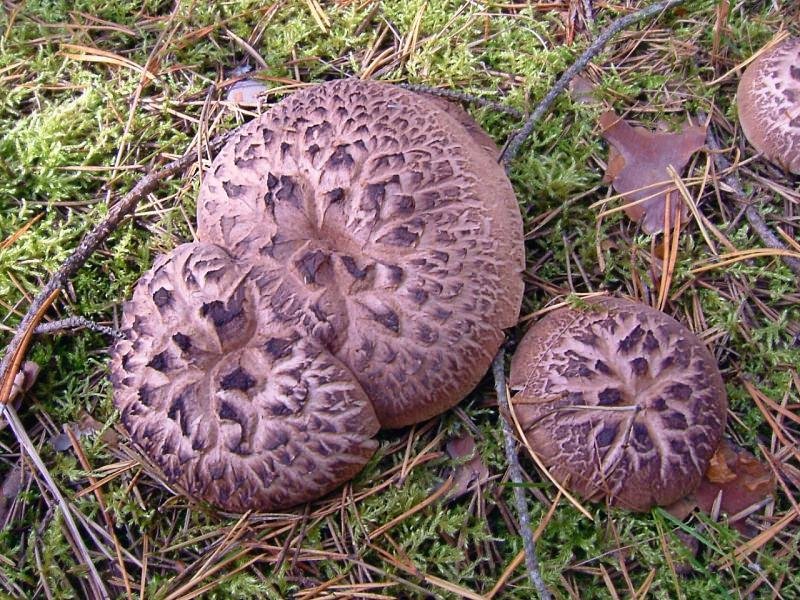
Hat: at first the hat is flat-convex, then it becomes concave in the middle. In diameter 25cm. Covered with tiled lagging brown scales. Velvety, dry.
Flesh: thick, dense, whitish-gray in color with a spicy odor.
Disputes: on the underside of the cap there are densely spaced conical spines, pointed thin, about 1 cm long. At first, the thorns are light, but with age they become darker.
Spore powder: brown.
Leg: 8 cm long. 2.5 cm thick. Solid, smooth cylindrical shape of the same color with a cap or slightly lighter. Sometimes there are specimens with a purple stem.
Distribution: Hericium flaky occurs in coniferous forests. Growing time is August - November. A rather rare mushroom that grows in large groups. Prefers dry sandy soils. Distributed in all forest zones, but not equally, in places it is absent altogether, and in places it forms circles.
Similarity: The scaled herd's man can only be confused with similar species of herringbone. Related species:
- Finnish Hericium, characterized by the absence of large scales on the cap, dark pulp in the stem and an unpleasant, bitter or peppery taste
- Hericium is rough, which is slightly smaller than motley, with a bitter or bitter aftertaste and, like the Finnish, dark flesh in the leg.
Edible: The mushroom is good for human consumption. Young mushrooms can be eaten in any form, but tastes best when fried. The bitter taste disappears after boiling. Hericium scaly has an unusual spicy smell, so not everyone will like it. Most often, it is used as a condiment in small quantities.
Video about the Hericium scaly mushroom:
Remarks: Sarcodon imbricatus grows in the darkest and most inaccessible places on dry sandy soils.
Leena Riihelä, a super-master at dyeing wool with natural dyes, writes on her blog:
Here on WikiMushroom, Sarcodon squamosus is spelled out the old fashioned way, as a synonym for Sarcodon imbricatus. For the time being, these barnacles remain to be defined as one species, since the exact definition will be extremely difficult, and from a culinary point of view, there is not much difference.
Description of the red-headed hedgehog.
The cap of the red-haired hedgehog is irregular in shape, but sometimes it can be oval or ovoid. Its diameter is 6-12 centimeters. The surface of the cap is smooth. The color of the cap is yellow or reddish-orange, it depends on the place where the fruiting body grows. In dry weather, the cap fades and becomes ivory. The edges of the cap are brittle and thin.

The lower part of the cap is covered with needles-thorns that descend to the stem. These thorns are very brittle, they crumble with ease. The thorns are the spore-bearing layer of the rufous hedgehog. Spores are creamy or white.
The leg is complex, cylindrical, most often widened at the base. Its height is 6 centimeters and its diameter reaches 2.5 centimeters. The surface of the leg is fluffy. The leg of the red-haired hedgehog is weakly attached to the substrate.
The pulp is fragile, light. The pulp does not have a pronounced taste. With age, the pulp hardens, especially the stem of the mushroom.

Interesting facts about Bloody Tooth
Some Fun Facts About The Devil's Mane:
- In addition to the fact that this mushroom is very bright and beautiful, it is one of the interesting species from the point of view of biology. The connection of gidnellum with the environment of the forest, where it grows, is very dense. Scientists have found that mycelium binds to tree roots.
- Pitch is the most dangerous representative of the flora. Although the pulp does not pose any danger, a few drops of juice can kill a completely healthy person in a matter of minutes.
- The bloody mushroom often becomes the inspiration in the art world. Due to its truly deadly beauty, it is often seen at photo exhibitions.
- The mushroom juice is able to be absorbed into the skin, after which it cannot be completely removed from the body. After a quiet hunt, many mushroom pickers noticeably worsened their well-being, so experts strongly discourage even touching it.
- Gidnellum is spreading around the world in an unknown pattern. If a hundred years ago it could be found only in North America, then already in the 21st century it was seen in Iran and China.
- According to the research results, it was revealed that the mycelium can spread within a radius of 3 meters. This is a very high indicator among mushrooms, since the average spreading distance is no more than 1 meter.
Today, in order to find the devil's hedgehog, scientists use modern technologies that, by cultivating the soil, can find the DNA of the fungus. Since even if the bodies themselves cannot be visually detected, this does not mean that they are not at all. Mycelium can be stored in soil for years.
Species of the barnacle mushroom
Yellow Hericium (Hydnum repandum)
Edible mushroom.
The hat is 3-12 cm in diameter, fleshy, dry, dense, the surface is uneven, bumpy, the shape is irregular. A young mushroom has a slightly convex cap, the edges are bent down, the surface is velvety; as the mushroom matures, it flattens, the middle is crushed in, and the edge becomes wavy. Often grows together with the caps of neighboring mushrooms. The color of the cap is from light ocher and pinkish-yellow to reddish-orange and light hazel; darkens when pressed, and becomes light in dry weather. The pulp is dense, brittle, white or yellow, darkens at the break, the smell is pleasant, fruity. The old mushroom has a hard, bitter taste. The leg is 3-5 cm in length and 1.5-4 cm in thickness, dense, solid, cylindrical, widened at the base. The surface is smooth, dry, white or yellow, darkens with age.
The fungus grows in deciduous and coniferous forests, loves moss cover. It is found in the temperate zones of Eurasia and North America, as well as in Siberia and the Far East.
A yellow hedgehog appears at the beginning of summer and grows until the first autumn frosts.
Red-haired or reddish-yellow Hericium (Hydnum rufescens)
Edible mushroom.
The cap is smooth, irregular, reddish-orange in color. The edge is tucked up. Below the cap is covered with brittle spines. The leg is thick and dense. The pulp is dense, fleshy, cream-colored in structure, turns orange when pressed.
The mushroom grows in mixed and coniferous forests, in autumn.
Spotted Hericium (Sarcodon imbricatus)
The hat is 5-10 cm in diameter, dry, hard. The shape is flat-convex, in an old mushroom with a concave center; the edge is wavy. From above, the cap is covered with large scales that look like shingles. The color of the cap is brownish or grayish-brown, the scales are dark. The young mushroom has a velvety surface, the old one is smooth. The flesh is whitish in color, becomes dirty gray as it grows; in a young mushroom it is dense and juicy, in a mature mushroom it is dry and solid. Spicy aroma, taste with bitterness. The leg is dry, thick, cylindrical, widened downward; 2-5 cm long, 1-1.5 cm thick. The color of the leg is grayish, at the base it is brown.
Grows in dry coniferous forests, sometimes in mixed, on sandy soils, singly and in groups.
Fruiting occurs from August to October.
Conditionally edible mushroom. Young mushrooms are salted, pickled, dried, used as a seasoning.Old mushrooms are not used for food.
Hericium coralloides
The fruit body looks like a branch of a coral, branched, white or pinkish in color. The flesh of a young mushroom is white, gradually turns yellow, the smell is not pronounced. It grows on the trunks and stumps of dead deciduous trees (aspen, elm, oak, birch).
Young mushrooms are considered edible, but they are not harvested, since they are listed in the Red Book.
Hericium erinaceus (Hericium erinaceus)
The fruiting body is up to 20 cm, weighs about 1.5 kg, the shape is round or irregular, from white to beige. The flesh is whitish, fleshy. Turns yellow when dry.
A rare species that grows on the trunks of still living or dead deciduous trees (oak, beech, birch) in the Amur Region, Khabarovsk Territory, Primorsky Territory, China, the Caucasus and Crimea.
The season runs from early August to October.
Hericium curly, or barbel hedgehog (Hericium cirrhatum)
The fruiting body is capped, white or pinkish, turns yellow with age. From above, the cap is covered with spines or felt. Fringed edge. The pulp is thick, soft, white or pinkish, turns yellow when dry.
Only a young mushroom is edible.
Grows in July-September in deciduous and mixed forests of the Northern Hemisphere species.
Pseudohydnum or pseudohydnum (Pseudohydnum)
Fruit bodies are spoon-shaped, fan-shaped or lingual. The hat is up to 7.5 cm in diameter, thick, with a tucked edge. Above, the cap is smooth or velvety, whitish, gray or brown, darkens with age. On the underside there are soft short white or grayish spines. Leg up to 5 cm in length. The pulp is gelatinous, soft, translucent, the smell and taste are fresh, resinous.
Conditionally edible mushroom, rarely eaten.
Grows in groups or singly, on decaying stumps and trunks of conifers, in Eurasia and North America, Australia.
Literature [| ]
- The world of plants: in 7 volumes / Ed. Academician A.L. Takhtadzhyan. T.2. Slime molds. Mushrooms - 2nd ed., Rev. - M .: Education, 1991 .-- 475 p. (P. 354).
- Aurel Dermek. Mushrooms. - Bratislava: Slovart, 1989 .-- P. 58.
- Z.A. Klepina and E.V. Klepina. Handbook of the mushroom picker. - Moscow: AST-PRESS, 2006 .-- 256 p. (p. 59)
- "Mushrooms". Directory. / per. with ital. F. Dvin - Moscow: AST. Astrel, 2004 .-- 303 p. (p. 236)
- Lesso T. Mushrooms, determinant / per. from English L. V. Garibova, S. N. Lekomtseva. - M .: "Astrel", "AST", 2003. - S. 238. - ISBN 5-17-020333-0.
- Udu J. Mushrooms. Encyclopedia = Le grand livre des Champignons / per. with fr. - M .: "Astrel", "AST", 2003. - S. 77. - ISBN 5-271-05827-1.
Description of blackberry yellow
The cap of this mushroom is dry, dense, fleshy, with a diameter of 5-15 centimeters. The middle of the cap is usually concave. The surface is uneven, the edges are bent inward.

At a young age, the shape of the cap is slightly convex, and the surface is slightly velvety. The color of the cap is yellowish or pink-yellow, sometimes the cap can be almost orange.
The pulp is dense, with old age it becomes corky and begins to taste bitter. The smell of pulp in young specimens is pleasant. The color of the pulp is whitish-yellow. The lower surface of the cap is dotted with needle-like, short spines. They are very brittle. The color of the spines is yellow-pink. Spines descend on the leg. The leg is solid, dense, 2-8 centimeters long and 1-3 centimeters in girth. It is lighter in color than the hat.
Areas of growth of champlevé blackberries
These mushrooms are common throughout the temperate forest zone of the Russian Federation. They form mycorrhiza with a large number of tree species. Notched blackberries grow in forests, among shrubs, giving preference to moss cover. They can settle on any soil, but they love limestone more than that.

Yellow blackberries bear fruit from July to October. Fruiting bodies can appear in large groups and occur singly. Sometimes groups of mushrooms merge into a single whole, connecting with caps.
Similar species
The yellow blackberry has an external resemblance to two related species - the red-yellow blackberry and the whitish blackberry. These species differ only in slightly smaller size and color.The whitish blackberry has a whitish or almost white color, and the reddish-red blackberry has a reddish-yellow color. Both species have the same nutritional value, so it’s not scary to confuse them. If you look at the yellow blackberry from above, then due to the depressed shape of the cap, it can be mistaken for a yellow chanterelle.
Similarities to other mushrooms
Despite the fact that this species is very rare, there are similar specimens among the genus, which are also inedible and poisonous. As an example, Guindellum blue can be distinguished - it is often found in the northern part of Europe. She prefers sunny places. Unlike Peki, blue brethren live in small groups. To get acquainted with this view in detail, it is worth taking a look at the photo.
Hydnellum blue
The second representative, which can be attributed to the ranks of "doubles", is Gidnellum odorous. The mushroom is inedible and even dangerous. Small thorns appear on the lower part of it in adulthood, so it is very similar to the Peck. The main difference is the unpleasant smell of the pulp. It is very easy to confuse it with Pek, as the species prefers coniferous and spruce areas.
Hydnellum odorous
Description of the mushroom
Hericium white, or whitish (lat.Hydnum albidum or Dentinum albidum) originates from North America, but is now found in Europe, including Russia. Sometimes it is identified as a species of Yellow Hericium, and then it appears under the Latin name Hydnum repandum var. Albidum. The stress in the word "hedgehog" falls on the second syllable. Popularly, this mushroom is also called "White Blackberry", with an emphasis on the last syllable.
Hat
The cap of young representatives of this species is about 5 cm in diameter, slightly convex, the edges are bent down. As it grows, it straightens, the middle is retracted. As a result, its diameter reaches 12–17 cm. The color of the cap can be either pure white or grayish or yellowish, sometimes it is white with light gray or light yellow spots. Dry and velvety to the touch.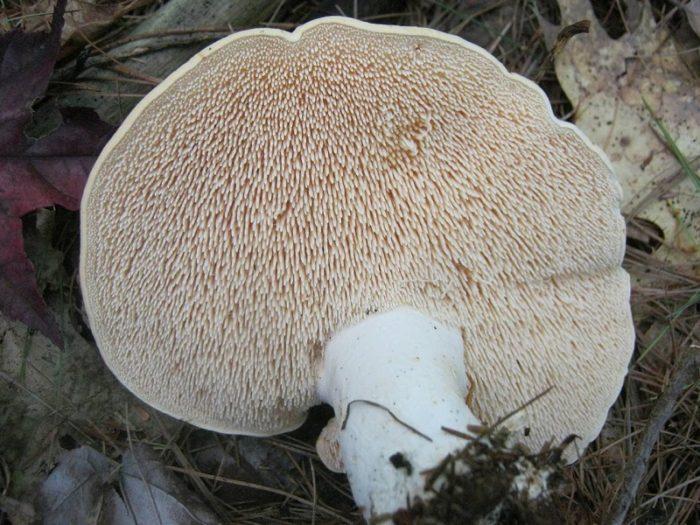
Hymenophore
It was the hymenophore - the underside of the cap, where the plates or sponges, which are familiar to all mushrooms, - gave the name to the genus of black-eyed people. The fringe of small, frequent spines really resembles the needle-like skin of a hedgehog.
Pulp
It is white and moderately dense in the mushroom, with a pleasant floral scent. In older specimens, it becomes hard like cork and tastes bitter.

